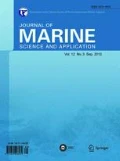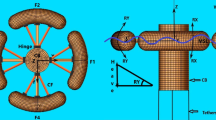Abstract
Many wave energy conversion devices have not been well received. The main reasons are that they are too complicated and not economical. However, in the last two decades direct conversion systems have drawn the attention of researchers to their widely distributed energy source due to their simple structure and low cost. The most well-known direct conversion systems presently in use include the Archimedes Wave Swing (AWS) and Power Buoy (PB). In this paper, these two systems were simulated in the same conditions and their behaviors were studied in different wave conditions. In order to verify the simulations, results of the generator of the finite element computations were followed. An attempt was made to determine the merits and drawbacks of each method under different wave conditions by comparing the performance of the two systems. The wave conditions suitable for each system were specified.
Similar content being viewed by others
References
Bredmo A, Falnes J, Lillebekken PM (1995). Conversion of wave energy by twin oscillating water columns. 2nd European Wave Power Conference, Lisbon, 1–5.
Budal K, Falnes J, Kyllingstad A, Oltedal G (1979). Experiments with point absorbers. 1st Symposium on Wave Energy Utilization, Gothenburg, 1–5.
Budal K, Falnes J (1980). Interacting point absorbers with controlled motion. Count, B.M. (Ed.), Power from Sea Waves. Academic Press, New York.
Budal K, Falnes J (1982). The Norwegian wave power buoy project. 2nd Symposium on Wave Energy Utilization, Trondheim, 1–5.
Danielsson O, Eriksson M, Leijon M (2006a). Study of a longitudinal flux permanent magnet linear generator for wave energy converters. International Journal of Energy Res., 30, 1130–1145.
Danielssonn O, Eriksson M, Leijon M (2006b). Study of a longitudinal flux permanent magnet linear generator for wave energy converters. International Journal Energy Res., 1130–1145.
da Costa J, Sarmento A, Gardner F, Beirao P, Brito-Melo A (2005). Time domain model of the Archimedes Wave Swing wave energy converter. 6th European Wave and Tidal Energy Conference, Glasgow, 91–97.
Falnes J (2007). A review of wave-energy extraction, Marine Structures, 20,(4), 185–201.
Falnes J (2002). Ocean waves and oscillating systems. Cambridge, Cambridge University Press.
Khalid Mohamed Nor KM, Arof W, Wijono HA (2004). Design of a 5kW tubular permanent magnet linear generator. 39th International Universities Conference of Power Engineering (UPEC2004), 2,(6–8), 528–532.
Haj Babaei N, Azarmsa SA (2005). Evaluation of predictive models for wind waves and Introducing a proper Model for Babolsar Coasts. Iranian Journal of Sea Sciences, 3,(1), 15–30.
Ivanova IA, Bernhoff H, Agren O, Leijon M (2005a). Simulated generator for wave energy extraction in deep water. Journal of Ocean Engineering, 32, 1664–1678.
Ivanova AI, Agren O, Bernhoff H, Leijon M (2005b). Simulation of wave-energy converter with octagonal linear generator. IEEE Journal of Oceanic Engineering, 30,(3), 619–622.
Leijon M, Bernhoff H, Berg M, Ågren O (2003). Economical considerations of renewable electric energy production—especially wave energy. Journal of Renewable Energy, 28, 1201–1209.
Leijon M, Bernhoff H, Ågren O, Isberg J (2005). Multiphysics simulation of wave energy to electric energy conversion by permanent magnet linear generator. IEEE Trans. on Energy Conversion, Piscataway, USA,, 20,(1), 219–224
Leijon M, Danielsson O, Eriksson M, Thorburn K, Bernhoff H (2006). An electrical approach to wave energy conversion. Journal of Renewable Energy, 31, 1309–1319.
McCormick ME (1973). Ocean engineering wave mechanics. Wiley, London.
Mueller MA (2002). Electrical generators for direct drive wave energy converters. Gen. Tran. Dist. IEEE Proc 2002, 149(4), 446–456.
Mueller MA and Baker NJ (2002). A low speed reciprocating permanent magnet generator for direct drive wave energy converters. Int. Conf. Power Electronics, Machines and Drives, Bath, UK, 487, 468–473.
Mueller MA, Polinder H, Baker N (2007). Current and novel electrical generator technology for wave energy converters. 7 th IEEE International Conference on Electric Machines & Drives2007(IEMDC’07), Antalya, Turkey, 3–5,(2), 1401–1406.
Mueller MA, Baker NJ (2002a). A low speed reciprocating permanent magnet generator for direct drive wave energy converters. Int. Conf. Power Electronics, Machines and Drives,, 487, 468–473.
Mueller MA (2002b). Electrical generators for direct drive wave energy converters. Proc. Inst. Elect. Eng. Gen., Tran. Dist, 149,(4), 446–456.
Mueller MA, Baker NJ, Spooner E (2000). Electrical aspects of direct drive wave energy converter. 4th Eur. Conf. Wave Energy, Aalborg, Denmark, 235–242.
Ohashi S and Matsuzuka T (2005). Basic characteristics of the linear synchronous generator using mechanical vibration. IEEE Trans. Magn., 41,(10), 3829–3831
Polinder H, Damen MEC, Gardner F (2005). Design, modeling and test results of the AWS PM linear generator. Euro. Trans. Electr. Power, Wiley, 15, 245–256.
Polinder H, Gardner F, Vriesema V (2000a). Linear PM generator for wave energy conversion in the AWS. ICEM 2000, Espoo, Finland, 1–7.
Polinder H, Gardner F, Vriesema B (2000b). Linear PM generator for wave energy conversion in the AWS. International Conference on Electrical Machines (ICEM), Espoo, Finland,, 309–313.
Polinder H, Damen MEC, Gardner F (2005). Design, modeling and test results of the AWS PM linear generator. Euro. Trans. Electr. Power, 15, 245–256.
Pinto P (2004). Time domain simulation of the AWS. Master’s Thesis, Technical University of Lisbon, IST, Lisbon.
Rhinefrank K, Agamloh EB, von Jouanne A, Wallace AK, Prudell J, Kimble K, Aills J, Schmidt E, Chan P, Sweeny B, Schachera A (2006). Novel ocean energy permanent magnet linear generator buoy. Journal of Renewable Energy, 31, 1279–1298.
Wang J, Jewell GW, Howe D (1999). A general framework for the analysis and design of tubular linear permanent magnet machines. IEEE Trans. Magn., 35,(3), 1986–2000.
Wijono HA, Nor KM (2003). Linear generator: design and simulation. National Power and Energy Conference (PECon), Bangi, Malaysia, 306–311.
Author information
Authors and Affiliations
Corresponding author
Additional information
Foundation item: University of Tehran Research Grant
Jawad Faiz is Professor. He received the Ph.D. degree in Electrical Engineering from the University of Newcastle upon Tyne, England in 1988. He is now a Professor at School of Electrical and Computer Engineering, University College of Engineering, University of Tehran. He has received a number of national and international awards. His teaching and research interests are switched reluctance and VR motors design, design and modeling of electrical machines and drives, transformer modeling and design and fault diagnosis in electrical machinery.
Mahdi Ebrahimi-Salari received the B.Sc. degree in electrical engineering from Islamic Azad University, Bojnord branch, Iran, in 2007 and M.Sc. degree from Islamic Azad University, Najaf Abad branch, Iran in 2009. He is a member of the Iranian young researchers club. His research interests include design and modeling of electrical machines, Power electronics and Renewable energy resources.
Rights and permissions
About this article
Cite this article
Faiz, J., Ebrahimi-Salari, M. Comparison of the performance of two direct wave energy conversion systems: Archimedes wave swing and power buoy. J. Marine. Sci. Appl. 10, 419–428 (2011). https://doi.org/10.1007/s11804-011-1087-9
Received:
Published:
Issue Date:
DOI: https://doi.org/10.1007/s11804-011-1087-9



